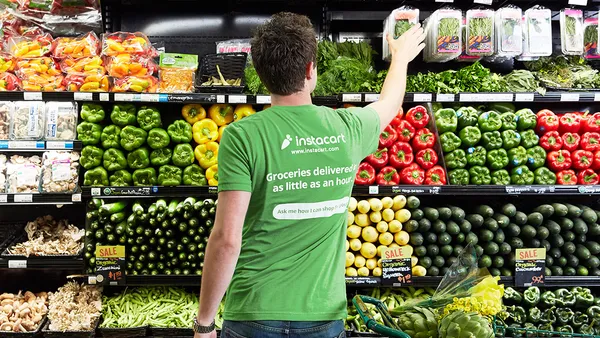Bobby Gibbs is a partner in Oliver Wyman’s Retail & Consumer Goods team. He works with food retailers to improve their customer value proposition through better capabilities.
Generative artificial intelligence (AI) and the Large Language Models (LLMs) that power them will massively disrupt food retail. While it’s not yet clear how long that will take, there are already scalable GenAI solutions that can drive revenue and improve productivity.
Companies that fail to take advantage of GenAI’s opportunities are going to fall behind.
You do not need to be a first mover or employ an army of data scientists to get value from GenAI. What you do need is to understand that GenAI is neither merely a novelty nor a viable replacement for your entire workforce.

My colleagues have measured 2% to 5% sales lifts when retailers incorporate GenAI and other personalization elements into existing promotional programs without any additional discounts. They also see a 25% reduction in time needed to complete simple tasks like writing meeting summaries, consolidating research or checking for grammar and usage using professional services firm Marsh McLennan’s LenAI.
Still, myths and misperceptions around GenAI continue to proliferate across the industry, creating barriers to adoption. Leaders must identify and dispel them if they want to realize the full benefit of the technology’s potential.
Learning to trust GenAI
There are numerous articles highlighting the potential shortcomings of AI, from the likelihood of hallucinations and data leakage to faulty image generation and risks from unsafe meal recipes.
These issues typically occur when people try to use LLMs to gain knowledge — for example, asking a generally trained model to solve a math problem. A GenAI model is better used for its skills: In this case, asking it instead to look up the answer from a validated set of solutions that have been loaded separately.
The key to using a model for its skills is to supply the right information, including existing document stores, trusted third-party sources, meeting transcripts and operational system data models. An additional benefit is that as business realities change, updated inputs keep the GenAI tools current.
Security is another often touted — but overblown — shortcoming. Many of the public-facing LLM solutions do not protect data. Information fed into these using the consumer prompts as questions can be accessed by other users in the future — which is how technology companies’ source code ended up in the public space. However, using LLMs does not necessarily pose the security threat for company data that some leaders fear. Corporate subscriptions via secure endpoints do not expose the data they access or even the questions asked to the outside world. These are no riskier than the cloud providers currently powering much of the internet broadly and internal processes at retailers and manufacturers today.
The reality is GenAI tools are already consumer-grade. Failing to deploy a secure, user-friendly, ‘employee-grade’ solution under a corporate information security schema increases the likelihood of employees exposing proprietary information to the public by finding unsafe alternatives. Research by the Oliver Wyman Forum shows that 15% of retail employees are using AI at work — and that nearly half of those are doing so without their employers’ knowledge.
Worries over costs and resources
Another common myth is that implementing GenAI requires a major infrastructure investment.
Enabling associates to access LLMs via corporate subscriptions to third-party models requires only a few days of development and a low cost per user. Companies do not need to train their own models — the models stay in the domain of the major tech companies, which will continue to invest in features that they can use to bolster their cloud offerings. Some retailers lower their cloud computing costs by allocating resources across multiple providers to create negotiating leverage. I expect the same will be possible with LLMs.
With many retailers and manufacturers making net-zero commitments, there’s also an unfounded concern that using LLMs will have a negative environmental impact from the energy costs required to train them.
The computational intensity required for an individual user, or even a company, is significantly lighter for models that are already trained — especially those tied to cloud services. As the cloud providers find ways to live up to their own climate pledges (many data centers are already carbon neutral), the providers will offset the climate impacts of training these shared-use models and reduce the impact of individual uses through improvements in computer chip efficiency, more usage of greywater cooling systems and other carbon reduction techniques.

Using GenAI in food retail — finding the value
Our clients have seen four main areas for use cases for GenAI that can drive down costs and spur net new growth in the food industry.
Drive efficiency via augmentation
GenAI tools massively accelerate the ability to perform key tasks. They excel at simplifying and integrating multiple data inputs, allowing teams to spend less time searching and summarizing and more time formulating a response. My colleagues developed a tool, LenAI, that in the early part of the year led to a 20% increase in time spent on value-add activities such as preparation for trade partner collaboration discussions, internal line reviews and financial governance.
The efficiency improvements are not just for roles specific to the food industry. Programming and code development, copywriting and talent management are just a few cross-industry functions already being augmented by production-grade GenAI solutions.
Work with a “co-pilot”
GenAI tools also can make it easy to access complex data stores, acting as a connector between the user and the many systems where retailers and manufacturers store data. Microsoft’s Copilot and Google’s Duet AI both do this in the core productivity tools many use today for word processing, email and spreadsheet analyses.
I have seen industry-specific examples as well – for instance a store associate assistant that allows the user to tap into production guides, customer feedback, store financials and other sources through a single chat interface. This reduces the training required to onboard new associates and improves adherence to best practices.
Hyper-personalized engagement
GenAI tools make it easy to engage with shoppers using individualized narratives, stories and experiences. Several retailers and consumer products brands are already using GenAI solutions to generate marketing copy for personalized outreach via email, SMS, WhatsApp and more. These bypass the traditional segment-based approaches for differentiating marketing and unlocking true 1:1 relevance.
Reinvent value proposition
Finally, as part of an integrated approach, GenAI tools can unlock new forms of commerce that transform business results. For example, GenAI can serve as a cornerstone for a conversational commerce experience that does far more than just let customers ask questions. Several retailers are using GenAI to power chatbots with higher capabilities. Carrefour’s Hopla, a chatbot based on ChatGPT that went live on the Carrefour website starting on June 8, was an early mover.
These chatbots are just the first step as retailers completely redesign shopping journeys away from the grid-based product displays and move toward more dynamic groupings of products around shopping lists, meal plans and customer decision trees.
A tool, not a solution
Even while GenAI has so many viable use cases in the market today, it is just one of the tools that the food industry should be using to improve business performance. Personalization will greatly benefit from integrating GenAI.
At the same time, numerous integrations are necessary to create an end-to-end personalized experience. GenAI is not a replacement for the machine learning algorithms that identify the best merchandising offers for an individual customer. Likewise, there is too much eagerness to apply GenAI to supply chain challenges when in fact what is needed is more accurate forecasting, better product visibility and routing optimization. GenAI solutions may support more efficient development of analytical solutions but are not a replacement for the hard work of data source identification and cleaning, model selection, and parameterization and tuning.
Still, there are so many reasons to be bullish on the applicability of GenAI. There is an undeniable level of excitement at its potential and new capabilities continue to roll out month after month.
The best time to begin developing GenAI solutions may have been January of this year. The next best time to begin is right now.












